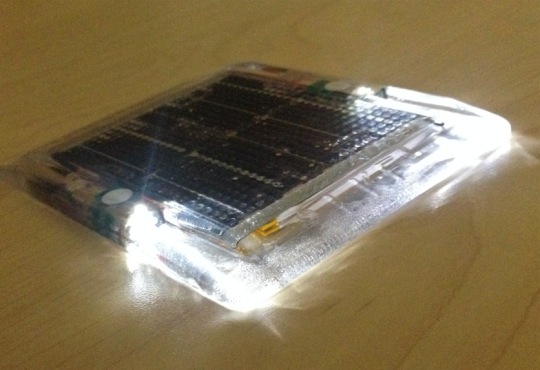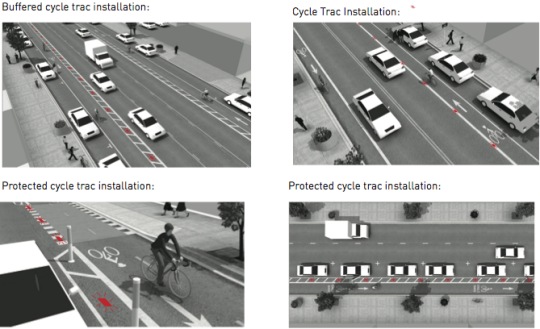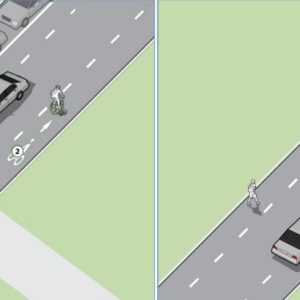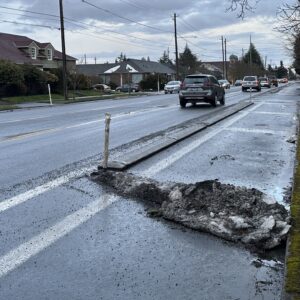The Portland Bureau of Transportation will install the city’s first illuminated bike lane markers next week (sorry, it’s not the glow-in-the-dark “starpath” everyone’s talking about). According to PBOT Active Transportation Division Manager Dan Bower, on Tuesday crews will install 20 solar-powered LED lights in the bike lane stripe on NE Couch as it makes the s-curve onto the Burnside Bridge (a somewhat notorious location if you recall).
The lights, which are only 7 millimeters tall, will be installed flush with the ground about every 15 feet (see below). They’ll turn on automatically as the sun sets. Bower told us he first saw them in use in Denmark (where they’re made) and thought they could be helpful safety and wayfinding devices here in Portland. Saris Racks is importing the lights from Denmark (apparently the company wants to get into the U.S. bikeway building boom) and they have donated the lights to PBOT for this pilot project. The price of each light, including the epoxy to secure them into the ground, is $140.

the existing strip/buffer area.
(Graphic: BikePortland)
Bower said PBOT has purposefully timed the installation of the new lights to coincide with the end of Daylight Saving Time. While the lights will help with the safety issue of people driving into bike lanes (especially on curvy roads), Bower said, they are not meant as as substitute for physically separated lanes. “These lights don’t replace better design,” he said, “I’d rather have a curb, but I don’t have the money for a curb.”
Since the lights will be installed flush with the pavement, there shouldn’t be any noticeable bumps to drivers or riders. And, although the solar panels and LEDs are encased in a plastic shell, the surface is textured so slippage should not be an issue. According to Saris, the lights can be seen from 1000 meters away and have a battery life of 5-10 years.
There are several different colors available, but PBOT’s first run will be white. Here’s how it looks lit up…

Bower said PBOT will look to expand the use of these lights if the pilot program is successful. Another area he mentioned that might benefit from these is the southwest corner of SW Broadway and 6th — a bike lane that is frequently encroached on by drivers.
A Saris product fact sheet (PDF) shows several implementation examples…

Along with helping provide a visual cue for the presence of a bike lane, another common use of these lights is to help illuminate paths like the Springwater Corridor at night.
For what it’s worth, Portland is the first U.S. city one of the first U.S. cities to test these lights in a real-life, urban conditions. Saris hopes the Portland launch will provide them with useful product feedback and help garner additional customers in other cities.
Stay tuned next Tuesday for a follow up post once these are installed.







Thanks for reading.
BikePortland has served this community with independent community journalism since 2005. We rely on subscriptions from readers like you to survive. Your financial support is vital in keeping this valuable resource alive and well.
Please subscribe today to strengthen and expand our work.
These will be of great help when it comes time to see the gravel PBOT lays down to help drivers and hinder cyclists each winter.
>”Since the lights will be installed flush with the pavement, there shouldn’t >be any noticeable bumps to drivers or riders.”
Cyclists have long served as the “bump” to let drivers know they have strayed. So, there’s still that.
This is so exciting! I didn’t know about this but noticed spray paint markings along the bike lane today and wondered what they were for – must have been for these.
so… these lights were donated but still had to pay $140 each light? or that is what would be the cost?
they didn’t cost PBOT a cent. They were donated by Saris. Sorry if that wasn’t clear. I just included the cost so folks knew how much they cost if we were to use them more in the future.
“southwest corner of SW Broadway and 6th” This sounds like an intersection which isn’t possible. These streets are parallel to each other. Do you mean the lanes on each of these streets?
Nope — I thought this too, but it turns out I just don’t know SW very well. Look at the google map link included in the post. It’s pretty far south (of downtown) — right after Broadway crosses 405, it swings east and crosses SW 6th at a diagonal.
Uhm, I actually saw some of these in Gresham, used as curb markers, not bike lane markers. They weren’t working. Hopefully these are from a different manufacturer, because it would really be great if they do work, especially as we slide into the coming arctic darkness months and the end of Daylight Savings Time. I can think of many locations where they would be welcome addition to paint!
Jonathan – Daylight Saving Time. I have my savings in chrome-plated steel. Love, WERDNERD
Hmm, those have potential as path lighting in my yard . . .
I will be interested to see how well they work. It is a cool idea.
I hope they address the signal timing to access this spot from the south. I currently use 6th Ave. Travelling n’bound on 6th, i ending up waiting at Burnside, while watching the light at Couch turn green. IF I am the first in line, and I take the lane and sprint, I can make it through the yellow light on Couch. Not a major issue, but very irritating!
For what it’s worth, Portland is the first U.S. city to test these lights in a real-life, urban conditions.
This may not be the first time these particular lights have been used in the U.S. What about these Milwaukee Ave solar powered bike lane lights featured on the Chicago Bicycle Program Facebook page?
https://www.facebook.com/photo.php?fbid=682547991762892&set=a.127928330558197.18818.113158208701876&type=1&theater
I live in Chicago and I’ve never heard of this.
Chicago has two pilot locations for these lights. Here is the second one:https://www.facebook.com/photo.php?fbid=642169205800771&set=a.127928330558197.18818.113158208701876&type=1&theater
THEY’RE TOTALLY THERE!! I saw them this week on Milwaukee ave between Kinzie and the freeway spur, northbound. They’re pretty amazing.
Good general idea to try out this product for improved safety [but perhaps there are better locations, given that these units might be better located in locations where the traffic does not have good streetlighting AND headlights…like on trails to mark bollards or other hazards/ centreline approaches to choke points such as intersections/ bridges.]
The Couch type location would seem to be equally and more affordably (if not free) addressed with traditional countersunk reflectorized RPMs given all the auto traffic with headlamps and street lighting.
…Though Good to hear that these solar studs will be countersunk into the pavement to protect them from snowplows.
Background…The “solar studs” have been in the market in various forms for almost 10 years…and adopted in other parts of the world more quickly that the MUTCD affected zone…more recently (2011) I have seen them pop up in places like Lake Havasu etc.
My memory of pricing per unit was closer to $40 vs. $140…but this might be the battery spec, unit profile etc. or an outcome of the small market / middleman distribution/ regulatory review costs.
So when the batteries die, can they be replaced, or do the lights have to be pried out of the pavement and a new one installed and the old one gets tossed? Hopefully the batteries can be swapped out.
Unlikely as the light assembly is rated IP68 which basically means it is rated for used under continual submersion and dry dust. The cheapest and most durable way to do this is by thermoforming the plastic body around everything inside thereby eliminating any holes; machine screws and gaskets are prone to weather damage and easy theft so are avoided.
I sent a request for more detailed info and will forward anything useful.
Regardless, the low current draw of LEDs, the physical volume available for a battery and the listed operation time of 4,000 hours without a charge suggests that whatever battery chemistry is used it will be in a very very low demand use design and therefore should last longer than normal consumer electronics battery paradigms.
I would expect the batteries will outlast the intended life of the device. Maybe 3-5 years.
Then again, Portland cars use studded tires and chains in the winter. Lets see if they make through the winter. It should be a tough test.
Wouldn’t be bad to see these at crosswalks if they can be triggered when the button is pressed.
This technology exists but it is not very durable. Portland instead uses pedestrian activated flashing signs, which are cheaper and more effective.
I have some concerns that these may be less bright than the throwaway lights that TriMet gives out.
The only two photos of this in operation on the Saris website kinda looks like long exposure photos due to the enhanced background detail in want otherwise looks like normal nighttime scenario.
But heck, at free the price is right. Let’s just not commit to a purchase until these prove to be an improvement over the status quo.
That SW Broadway and 6th corner is a disaster. I always take the lane there.
Should be interesting. This is along my commute route but after pushing the front wheel through gravel one morning I take the lane every time.
Los Angeles uses a super bright, non solar version on a highway to indicate no lane changes.
http://caltransd7info.blogspot.com/2012/11/ask-caltrans-why-are-there-lights-in.html
Theres a video in that link as well.
Heres another one (go to second 35)
http://www.youtube.com/watch?v=h_LQTsU1KDg
What’s wrong with reflectors? You get a lot more reflectors for the money.
I see in the illustration that there are street lights there already. Also Cyclists are required to use headlights at night.
Also Motorists are required to not drive in the bike lane, which is the reason these lights are being implemented in this location.
Fair enough. It will be an interesting test trial. I hope they succeed.
How about some solar-powered lights on the Springwater Corridor?
According to the Oregonian, UW-Madison Traffic Engineering school is experimenting with using these on a South Madison Wi Suburban trail (Fitchburg). This is my undergraduate university and I know that trail…I will post a link to a friend of mine who live right near there and see what he thinks of them. He uses that trail all the time.
http://www.oregonlive.com/commuting/index.ssf/2013/10/video_portland_will_test_solar.html
Of course the anti-bike commentators are out in force….it is like they can not understand what the words “free to the city of Portland” means.
They were DONATED.
you get a lot more donated reflectors for the money…
Always interested in seeing new treatments tried – as a daily rider through this I’ll be watching to see if it improves my experience any. Although right now, I’m at a loss as to what these will help.
If I had my choice, I’d rather have a transition painted from the bike lane into the through lane on the west end of the bridge. The interaction between cars and bikes at this transition point is dicey at best. Makes me nervous each and every morning.
How about a few flexible plastic bollards leading up to the right curve. Doesn’t need to be a forest of bollards; just a few to delineate the bike lane and dissuade drivers from encroaching. Won’t interfere with bikes since you will be leaning away from the bollard.
I find it odd that they would want a curb there… then bikes couldn’t pass each other… enforcement of the bike lane is the only solution…
I could see these on freeway ramps at rest areas.
It would be nice to have these at cross walks where they turn on when you push the cross button.
For the record, there are two elements of the Couch Curve that were incorrectly engineered, and have negative effects on the rideability of the bike lane.
First, there is no storm sewer drain in the bike lane.
Streets are supposed to be designed so that the rainwater flows form the middle of the road off the the edges, then downhill along the gutters to a storm drain. This gets the water off the roads and gets the debris off the road.
PBOT engineers didn’t do this on the Couch Squiggle.
Stormwater drains off the the sides of the road, and down the gutters. On the right hand side, where the bike lane is, it drains downhill from MLK into the squiggle, and downhill from Burnside into the squiggle. Then, in the middle of the squiggle, the road itself dips, and the stormwater flows in a river across the street, from right to left. And goes down a storm drain on the left hand side. They didn’t slope the concrete gutter to the left, through, so there’s always a puddle and a pile of debris in the gutter at the low spot.
Very unconventional, I haven’t seen this anywhere else, anywhere.
It creates a couple serious safety issues.
1) There’s always a bit of debris in the bike lane, sometimes a lot of debris.
2) When its raining, there’s always a stream of water crossing the bike lane at the dip. Bikes have less traction when going through water. And the water is carrying debris across the road, through the bike lane.
3) When its raining, cars drive through the stream and splash bikes. Not good for visibility, and a disincentive to ride a bike.
Second, the inside car lane is way too narrow. So cars barely fit in it, and buses and trucks don’t even come close to fitting in the lane. So they take up part of the outside lane, forcing vehicles in the outside lane to take up the bike lane.
When curves are engineered, the lane needs to be wider going through the curve than on a straight section, because of the “sweep” of a long vehicles read wheels — a truck or a bus, going through a curve, will have the rear wheels follow a tighter radius than the outside wheels.
Here’s a diagram
http://onlinemanuals.txdot.gov/txdotmanuals/rdw/images/7-1.png
An animation would be better, but I can’t find one.
So, a correctly engineered curve has a lane width that tapers wider on the approach to the curve, is wide through the curve, then tapers back down to the standard width after the curve.
But, if you look at a aerial photo of the Couch Squiggle, you see that the car lanes are widened on Couch through the first of the two curves, but are not widened through the 2nd of the two curves.
http://goo.gl/maps/wUZ7K
The outside lane, closest to the bike lane, is fairly wide through the whole squiggle. So long vehicles, like buses and trucks, can get through it in their lane, if they steer correctly. But there is zero margin of error. If you stand there in the dirt between MLK and the squiggle and watch the bus wheels carefully, you’ll see that they can just barely fit in that fat lane. And if drivers that can’t hack it will either have the front end of the bus over the line into the left lane, or the back end of the bus in the bike lane, or buffer.
The inside lane is considerably narrower, so its physically impossible for a long vehicle to drive in that lane and not slop over into either oncoming traffic on the bridge, or the outside lane. Most drivers will opt to slop over into the outside lane, since a sideswipe collision isn’t as dangerous as a head-on.
This engineering error results in vehicles slopping into the bike lane, all day, every day.
We will find out just how tough those lights are.
Part of the reason the plastic candle bollards on the Lovejoy ramp off the Broadway Bridge got crushed so fast was the same reason — a 53′ truck (like the Post Office uses) can’t actually fit into the skinny 10′ lane on the Lovejoy ramp, so they either slop into oncoming traffic (not an option when there’s cars in the lane) or the bike lane.
FWIW,
Ted Buehler
“encroaching” is the word I was looking for —
* a long vehicle can’t take the left lane through the 2nd squiggle without encroaching in the opposing traffic lane or the right lane.
* a long vehicle can only fit in the right lane through the 2nd squiggle if the driver steers it with exact precision, or it will encroach on the left lane, the bike lane, or both.
Wanna make it REALLY last?
Use subsurface lights under Light-Transmitting/Translucent Concrete.
If you use the fiber optic design principal in its fullest the cheapest (non-data quality fiber optic cables) fibers piped under the road surface in conduits with some sort of clear window everywhere needed to let the light out.
Then the actual energized light source(s) can be above ground, out of the road (for maintenance safety) and locked down in secure cabinets so they can’t be stolen or damaged.
Also, because the Translucent Concrete has fibers throughout its volume surface wear should not affect light coming out of the concrete surface.
If the technology becomes cheap enough we can envision road striping than can be actively reassessed, redrawn, and modified to accommodate a huge wave of cyclists or some nut trying to haul a double wide mobile hime through Portland. Or midnight rides on a TRON Light Cycle Grid; I don’t know what that geeky cycle-y game would be like but I say “Portland: Yes we can!”
Oops, i guess they’ll need to be brighter.